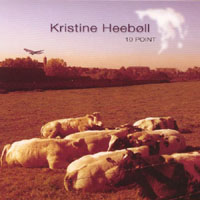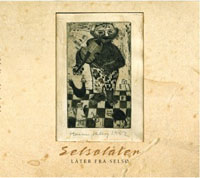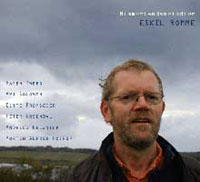Nordic roots. That’s what this review is about. We tend to refer to “Nordic trad” a lot around here at GMR, but it strikes me, surveying these CDs, that “traditional” is going to get bent badly out of shape, perhaps more than even I can justify. In this selection of recent releases, we have everything from older traditions in Nordic music to a more “modern” take on traditional music to explorations of jazz and new age starting from traditional tunes.
 Ragnhild Furholt, in Lån Meg Vengjene, brings us a sample of older Nordic traditions in the performance of folk music. She sought out old songs — pre-nineteenth-century melodies from old songbooks, sometimes with only one verse included — and has reconstructed them, filling them out from other sources. Her performances are marked, however, by innovative arrangements that add an appealing spark to the disc. “Jeg Lagde mig Saa Silde” and “Heim Kom Juringen” give a very strong feel of older music, similar to traditional songs in English that have come down from the sixteenth century, while “Venerus” is a particularly lovely song, showing off the purity of Furholt’s voice in its higher range. “Mølldottera,” with its strong rhythm and Furholt’s almost staccato delivery, displays the weight she can bring to her material. (I have to confess to a disadvantage here: except for a translation of Furholt’s short essay and a paragraph about her, there is nothing in English on this CD, and Norwegian is not a language I’m comfortable in, to say the least. I have no idea what these songs are actually about, you see. But they are nice to listen to.)
Ragnhild Furholt, in Lån Meg Vengjene, brings us a sample of older Nordic traditions in the performance of folk music. She sought out old songs — pre-nineteenth-century melodies from old songbooks, sometimes with only one verse included — and has reconstructed them, filling them out from other sources. Her performances are marked, however, by innovative arrangements that add an appealing spark to the disc. “Jeg Lagde mig Saa Silde” and “Heim Kom Juringen” give a very strong feel of older music, similar to traditional songs in English that have come down from the sixteenth century, while “Venerus” is a particularly lovely song, showing off the purity of Furholt’s voice in its higher range. “Mølldottera,” with its strong rhythm and Furholt’s almost staccato delivery, displays the weight she can bring to her material. (I have to confess to a disadvantage here: except for a translation of Furholt’s short essay and a paragraph about her, there is nothing in English on this CD, and Norwegian is not a language I’m comfortable in, to say the least. I have no idea what these songs are actually about, you see. But they are nice to listen to.)
 Ragnhild Furebotten’s Endelig Vals is much closer to what we are used to as “traditional” music from what I can only call the “Britanno-Nordic complex.” This collection is a mix of traditional folk songs and original compositions by Furebotten, a fiddler of some accomplishment, and others, in a traditional mode. “Gildeskål/Beiarn,” which couples a schottisch and a reel, gives the best example of this collection’s feel: a nice energy level, quiet but with a good momentum, although the album as a whole struck me as — well, sober, if you know what I mean. There is a range of music here, as demonstrated by the contrast between “Gildeskål/Beiarn” and “Våkn oopp dur sotu sover,” a folk song from Saltdal, given a treatment with fiddle and cello that brings out the melancholy mood.
Ragnhild Furebotten’s Endelig Vals is much closer to what we are used to as “traditional” music from what I can only call the “Britanno-Nordic complex.” This collection is a mix of traditional folk songs and original compositions by Furebotten, a fiddler of some accomplishment, and others, in a traditional mode. “Gildeskål/Beiarn,” which couples a schottisch and a reel, gives the best example of this collection’s feel: a nice energy level, quiet but with a good momentum, although the album as a whole struck me as — well, sober, if you know what I mean. There is a range of music here, as demonstrated by the contrast between “Gildeskål/Beiarn” and “Våkn oopp dur sotu sover,” a folk song from Saltdal, given a treatment with fiddle and cello that brings out the melancholy mood.
 Kristine Heebøll is another fiddler, from Denmark, with her own take on “traditional.” 10 Point gives her interpretation of the traditional in songs that are both traditional and new. The title song is subtitled “Cuban Reel” — and if they play reels in Cuba, this is probably what they sound like. “Peralta/Edderfuglen” is another somewhat melancholy tune, described as “a march and a polska,” but which sounds more like a sad, sweet ballad that gradually picks up in mood, given full scope by the supporting forces, including more violin, viola, and cello. This one almost enters a classical idiom, with a nicely detailed polyphony that adds weight to the music.
Kristine Heebøll is another fiddler, from Denmark, with her own take on “traditional.” 10 Point gives her interpretation of the traditional in songs that are both traditional and new. The title song is subtitled “Cuban Reel” — and if they play reels in Cuba, this is probably what they sound like. “Peralta/Edderfuglen” is another somewhat melancholy tune, described as “a march and a polska,” but which sounds more like a sad, sweet ballad that gradually picks up in mood, given full scope by the supporting forces, including more violin, viola, and cello. This one almost enters a classical idiom, with a nicely detailed polyphony that adds weight to the music.
 “Selsølåter” brings together a group of musicians headed by Svend-Erik Pedersen, also from Denmark, with a series of lively dance tunes from the area of Selsø, west of Copenhagen. They are actually songs composed by Pedersen, beginning with “Totur fra Selsø” — a lively tune that would equally at home in Ireland. This is an upbeat collection that makes good use of a larger range of musical support — violins, for sure (it seems you can’t have traditional music without a fiddle), but also banjo, hammond organ, trumpet, clarinet, and a couple I can’t translate. We’re still in traditional mode, but things do start to bend a little, particularly with “1. april vals,” which comes close to being unclassifiable.
“Selsølåter” brings together a group of musicians headed by Svend-Erik Pedersen, also from Denmark, with a series of lively dance tunes from the area of Selsø, west of Copenhagen. They are actually songs composed by Pedersen, beginning with “Totur fra Selsø” — a lively tune that would equally at home in Ireland. This is an upbeat collection that makes good use of a larger range of musical support — violins, for sure (it seems you can’t have traditional music without a fiddle), but also banjo, hammond organ, trumpet, clarinet, and a couple I can’t translate. We’re still in traditional mode, but things do start to bend a little, particularly with “1. april vals,” which comes close to being unclassifiable.
 Eskil Romme’s Himmerlandsmelodier, with a discernible influence from jazz and world music, begins to head toward new age while still anchored in the traditional idiom. “Spring Peace,” which opens this collection, could be a ballad from almost anywhere in northern Europe or the British Isles. The jazz influence is apparent in “Around April,” with a Latin rhythm and passages of jazz-based improvisation. The colors in this album are not what we’re used to in “traditional” music, something that almost leaps out at us in “Esther,” a piece very much in the new age mode, in large part due to the combination of soprano sax with accordion, and even more apparent in “No-One Knows From Where,” another piece that leaves “traditional” far behind.
Eskil Romme’s Himmerlandsmelodier, with a discernible influence from jazz and world music, begins to head toward new age while still anchored in the traditional idiom. “Spring Peace,” which opens this collection, could be a ballad from almost anywhere in northern Europe or the British Isles. The jazz influence is apparent in “Around April,” with a Latin rhythm and passages of jazz-based improvisation. The colors in this album are not what we’re used to in “traditional” music, something that almost leaps out at us in “Esther,” a piece very much in the new age mode, in large part due to the combination of soprano sax with accordion, and even more apparent in “No-One Knows From Where,” another piece that leaves “traditional” far behind.
So, what it comes down to is that “traditional” is what you make of it, no matter what part of the world you’re from. You can still create some very listenable music.
(Talik, 2007)
(Talik, 2007)
(Go Danish Folk, 2007)
(Go Danish Folk, 2008)
(Tutl, n.d.)
